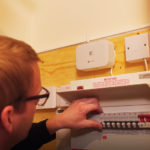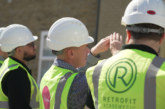Social housing fire checks and compliance are more important now than ever, with more people staying indoors and working from home due to the pandemic, say Tony Boyle, Regional Specification Manager, Central Scotland and David Cunningham, Regional Specification Manager, South London at Aico
When it comes to fire safety and fire alarms specifically, British Standard 5839-6:2019 is the best practice guide, giving an insight on every type of property from privately owned to social landlords. The minimum requirements a council or housing association should meet is stated in BS 5839-6:2019 as a ‘Category LD2 System’.
Category LD2 requires a fire alarm in areas that form part of an escape route, a heat alarm in the kitchen and a fire alarm in the principle habitable rooms. A principle habitable room is a room most used during daytime living, such as a living room, but this could also mean a bedroom or dining room — it is dependent on the property and residents. A Fire Risk Assessment would highlight the principle habitable room/s.
It is also vitally important that landlords can gain access to the property to carry out regular checks to ensure all life safety devices are working correctly. Understandably in recent times this has become far more difficult, with tenants shielding and lockdown measures having a significant impact.
Aico offers the ideal solution, its Ei1000G SmartLINK Gateway. It is designed for use with Aico fire and carbon monoxide alarm systems and provides a mechanism to transfer information from the wireless Radio Frequency network to a portal over the GSM network. It is mains powered with a rechargeable battery backup that can provide a power supply in case of mains failure.
Connected devices’ events are processed by the Gateway as they occur and cover events such as fire alarms, button test, faults, CO detection, head removal, end of life and much more. This means that issues surrounding access are greatly reduced and social landlords can monitor the fire and carbon monoxide alarm systems across their entire housing stock remotely.
Gateway to safety
Earlier this year we documented the installation of two Gateway projects, from specification to installation and beyond, gaining further insight into the benefits provided. Regional Specification Manager David Cunningham worked with the Hyde Group, who have over 50,000 homes across London, and recommended the SmartLINK Gateway. Each of the properties have now been fitted with an Ei3024 Multi-Sensor fire alarm and Ei1000G Gateway, giving the Hyde Group a proactive approach to fault-finding, defining any trends in alarm activations and maintenance requirements, while drastically minimising the issue of property access.
Compliance Contract Manager for Hyde, Jack Bernard, comments: “The location we initially installed the system in requires an enhanced monitoring function because it suffers from false alarms and tampering. The Gateway enables us to monitor the system in real time, providing specific and useable information to offer a truly safer home.”

Reliable technology
Charing Cross Housing Association has over 500 properties in the West End of Glasgow. Alasdair Weir, Maintenance Officer comments: “Charing Cross has been working with Aico over the past five years and we have built a really strong relationship. Recently we decided to trial fit an Ei1000G SmartLINK Gateway in a property following a host of false call outs for Carbon Monoxide alarm activations. There had been several out of hour engineer callouts with no fault found. After discussing the case with Tony Boyle, our Regional Specification Manager at Aico, we decided to carry out a trial of the unit.
“Since fitting the unit, this has proven as reliable as every other Aico unit the Association has fitted, giving real-time updates of the status of every alarm fitted in the household. What the Ei1000G SmartLINK Gateway has thrown up is a tenant with financial difficulties and real fuel poverty (the activations that were being heard were actually power outages and back up batteries being used) the Association has been able to step in and signpost the tenant to relevant agencies to try and get them the help they need.”









